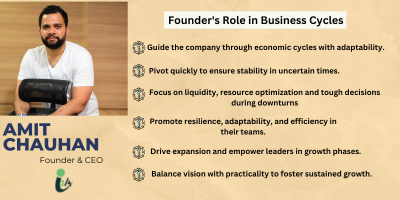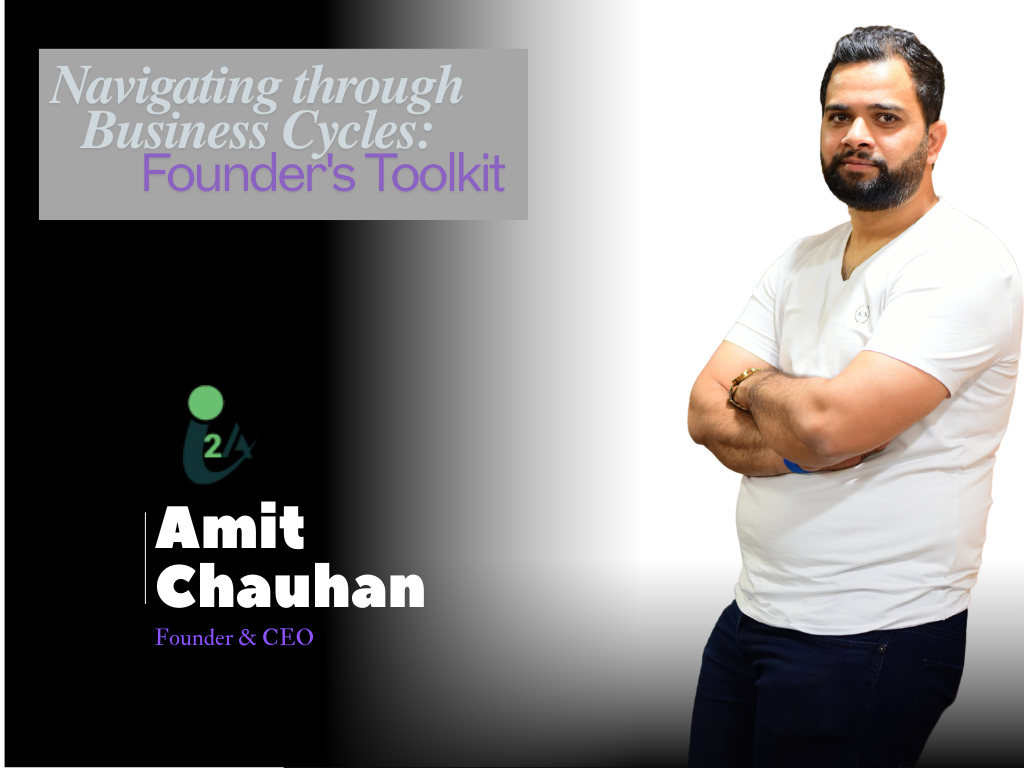Businesses operate within a continuous business cycle of economic activity—such as expansion, peak, contraction, and trough—that impact operations, strategy, and overall resilience.
Navigating the phases of business cycles requires businesses to not only to survive but to position themselves advantageously for both stability and growth.
Business environment is shaped by a range of controllable and uncontrollable factors. From PESTLE influences—Political, Economic, Social, Technological, Legal, and Environmental—to fluctuating market conditions, companies must stay attuned to changes that affect them both directly and indirectly.
Economic shifts interact with these external factors, creating a dynamic environment that requires businesses to focus on strategic planning, economic research, and flexibility to stay competitive.
In past downturns, even large corporations have faced steep declines or complete collapse, while small businesses often struggled to survive. Significant events, such as the dot-com bust and the 2008 financial crisis, underscore the vulnerability of even the most established companies during economic shocks.
Resilient businesses practice continuous learning and change management, helping them pivot when necessary. By fostering a culture that values flexibility and preparation, companies can mitigate the effects of economic shocks and keep their core operations stable.
Economic growth and cycles are further influenced by factors like government spending, federal reserve policies, and GDP growth.
Periods of growth present opportunities for companies to expand, while financial crises or recessions often demand swift adjustments to maintain stability.
Strategic realignment in response to economic cycles is key to a business’s resilience and adaptability. By regularly assessing the business environment, connecting with industry peers, and reviewing current economic data, companies can make informed decisions about scaling, investing, or restructuring.
Business Cycle: Definition
The business cycle represents the fluctuations in economic activity that an economy experiences over time, moving through periods of expansion and contraction. Rooted in economic theory, it captures the alternating phases of economic growth and decline. These cycles are identified by shifts in key economic indicators such as GDP growth, industrial production, consumer spending, and corporate profits. Economists measure these patterns to understand and anticipate changes in economic output, allowing businesses and policymakers to align strategies with the overall economic backdrop.
Business cycles are primarily measured by expert organizations like the National Bureau of Economic Research (NBER), specifically its Business Cycle Dating Committee. This committee determines the official timing of expansions and recessions based on economic indicators like real personal income, interest rates, and GDP growth. Additionally, institutions like the Federal Reserve Bank and the Bureau of Economic Research provide critical data to monitor economic cycles, while private entities such as The Conference Board contribute insights through their own business cycle indicators.
The significance of understanding the business cycle lies in its influence on national and global economic policies. During phases of economic decline, indicators such as rising unemployment and reduced consumer spending signal the need for economic intervention. Central banks, such as the Federal Reserve System, often respond with expansionary monetary policy, adjusting interest rates to stimulate growth and stabilize the economy. In times of expansion, however, strategies shift to prevent overheating, keeping the growth rate balanced for sustainable economic health.
Viewed within the larger economic framework, the business cycle provides insight into how various factors—including corporate profits, consumer demand, and government spending—interact to shape economic cycles. For businesses, this understanding helps in anticipating economic conditions and aligning decisions accordingly, whether in response to expansion or contraction. Monitoring business cycle indicators allows organizations to better prepare for the economic fluctuations that affect everything from hiring to investment strategies.
Phases of Business Cycle
Expansion
The expansion phase is the growth stage in the business cycle, where economic activity spreads across industries, fuelling an increase in aggregate economic output. During expansion, there is a steady rise in real GDP, employment, and national income, as well as heightened levels of consumer confidence and business investment.
Indicators of expansion include a rise in business cycle indicators like GDP growth, corporate profits, wholesale and retail sales, and industrial production.
The Federal Reserve Bank and other central banks may keep interest rates low to support this growth. Real personal income also typically rises, indicating an increase in consumers’ purchasing power.
A significant marker of expansion is a low rate of unemployment, along with increasing investment in capital goods, suggesting a healthy demand for products and services.
In the expansion phase the companies invest in new projects, hire additional staff, and expand operations. The expansion phase also provides favorable conditions for launching new products or entering new markets due to increased consumer spending and favorable credit conditions.
During the 2000s housing boom, U.S. businesses experienced a notable expansion as consumer demand and investment surged. Fueled by accessible loans and low interest rates from the Federal Reserve, companies in construction, real estate, and financial sectors thrived.
Peak
At peak stage, GDP growth plateaus, employment rates stabilize at high levels, and inflation pressures may increase. The peak is often the most prosperous part of the cycle but also indicates that economic activity is reaching saturation, signaling the likelihood of an upcoming contraction.
Business cycle indicators at the peak include high corporate profits, increased aggregate output, and record levels of investment and consumer spending.
The inflationary pressures may start to emerge, as demand for goods and services meets production limits. Central banks, such as the Federal Reserve System, may implement contractionary monetary policies, like raising interest rates, to prevent the economy from overheating.
For businesses, the peak phase presents both opportunities and challenges. Companies enjoy high revenue streams and stable demand, but increasing costs, particularly labor and raw materials, can squeeze profit margins. Business investments may slow down due to rising costs and higher interest rates, as companies prepare for potential downturns.
In 2019, the U.S. economy reached a peak after years of growth, driven by low unemployment, strong GDP growth, and consumer spending. Businesses across sectors saw high revenues, but as inflation concerns emerged, the Federal Reserve raised interest rates.
Contraction
The contraction phase, or recession, marks a period of economic decline where aggregate economic activity decreases across sectors.
Contractions typically involve a decline in GDP, reduced consumer spending, and increased layoffs, often due to an economic shock or an overextension during the peak. A financial crisis can occur during this phase, highlighting the vulnerability of businesses as the economy begins to shrink.
Key indicators of contraction include a reduction in GDP growth, rising unemployment, declining corporate profits, and a decrease in consumer confidence.
Businesses may experience lower demand, and central banks often respond with reduced interest rates and expansionary monetary policies to support the economy.
Business investments and production typically slow as the economy grapples with lowered aggregate demand. During contraction, businesses face declining sales, reduced profitability, and often have to cut back on spending or lay off employees.
Companies focus on managing cash flow and scaling back operations to preserve resources until the economy stabilizes.
The 2008 financial crisis is a classic example of a severe contraction. Following the housing market collapse, the U.S. experienced a significant decline in economic activity, with widespread unemployment and reduced consumer spending. Many businesses, particularly in finance and real estate, struggled to stay afloat, while others had to downsize or declare bankruptcy. The contraction phase led to a prolonged recession, impacting industries worldwide.
Trough Phase
The trough phase is the lowest point in the business cycle, where economic activity bottoms out following a contraction. This stage marks the end of declining economic output and signals the beginning of a recovery.
During a trough, GDP stops decreasing, and unemployment levels reach their peak. Although business investment is low, the economy is now poised for a gradual return to growth.
A trough phase can be seen when there is stagnant or minimal GDP growth, high unemployment rates, and low corporate profits. Consumer confidence is generally low, and economic activity remains subdued. Central banks and government institutions often step in with supportive measures like lowering interest rates, increasing government spending, or implementing fiscal stimulus to help stimulate the economy and encourage a return to growth.
For businesses, the trough phase is a time of cautious optimism, as they wait for signs of recovery. While consumer spending is limited and profits are low, companies often use this time to restructure, reevaluate strategies, and prepare for the next expansion. Businesses may also take advantage of lower costs and invest strategically to position themselves for growth as the economy rebounds.
The period following the Great Recession in 2009 exemplifies a trough. The U.S. economy hit its lowest point, with unemployment reaching record highs and consumer spending stalling.
Founder’s Role in Business Cycles

A founder’s role in navigating business cycles is pivotal, acting as both the compass and the captain steering the company through shifting economic waters. In times of uncertainty, the founder’s vision and adaptability become crucial assets, enabling the company to pivot, optimize, and make quick decisions to weather the storm. At each phase of the business cycle, from expansion to contraction, the founder plays an active role, transitioning from visionary to strategist to ensure stability and growth.
Here Amit Chauhan- Founder and CEO of I2A Technologies share his business wisdom:
“As the founder, I see my role as the pivotal force that turns ideas into action, aligning our company’s response to each phase of the business cycle. My experience, insights, and core values are what ground us during turbulent times and push us toward growth during expansion phases.”
When we hit contraction and trough phases, my responsibilities shift significantly. In these times, keeping liquidity strong, optimizing operations, and making difficult decisions become essential. I focus on what’s truly critical to our survival and sustainability, channelling resources where they can sustain revenue and cutting back on anything non-essential. I act as a filter, selecting ideas based on a deep understanding of the market conditions we’re in, informed by both my experience and economic insights. In these tough times, I know my values have to guide us, helping our entire team stay focused on a common goal and creating synergy across all departments.
Keeping resilience alive in my team is a top priority. I reinforce a culture of adaptability and a shared sense of purpose, encouraging everyone to prioritize efficiency and customer satisfaction. Leading by example is essential here—I make the same sacrifices I expect from my team and work closely with them to manage risks, optimize cash flow, and keep us steady. These are the times when my hands-on commitment is most important, showing our team that we can weather these phases together.
In times of expansion, my role shifts to one of vision and growth. Here, I’m focused on new opportunities—entering fresh markets, launching innovative products, and expanding our reach. I use this period of growth to empower other leaders within our organization, giving department heads and managers the chance to step up, take ownership, and drive our progress. This culture of ownership not only strengthens our foundation but also builds our capacity for sustained growth in the long term.
Balancing caution with ambition is crucial. I try to keep my decisions grounded, bridging our long-term vision with the practical demands of the moment. Each phase of the business cycle offers new lessons—refining our strategies in downturns, and driving growth in upturns. Every phase is an opportunity to grow stronger and more strategically aligned for the future.
Strategies for Navigating Economic Downturns
Cash Flow Management During Downturns
Cash flow represents the lifeblood of a business, especially during downturns when revenues may shrink and expenses remain constant. Monitoring and managing cash flow allows a business to maintain liquidity, ensuring it has enough funds to cover essential expenses, such as payroll, rent, and inventory.
Cash flow management during downturns involves careful economic analysis and forecasting to assess cash needs accurately. This might include reducing discretionary spending, negotiating longer payment terms with suppliers, or even tightening credit terms with customers to ensure quicker receivables.
Resource Allocation and Cost Optimization
As economic shocks affect corporate profits, businesses need to identify where they can cut costs without compromising essential operations. This process involves prioritizing resources toward the most critical functions and reallocating funds from non-essential areas.
In practical terms, cost optimization may mean delaying certain investments, renegotiating contracts, or finding more affordable suppliers. It also requires a strategic assessment of current operations to see where redundancies or inefficiencies exist.
Lean Business Model
A lean business model emphasizes efficiency, aiming to eliminate waste in every part of the business. This model focuses on maximizing value while using fewer resources, which can be especially valuable when economic cycles show signs of contraction and business investment slows down.
Implementing a lean business model helps businesses remain agile.
During downturns, companies can reduce excess inventory, streamline production, and focus only on high-demand products or services. For instance, after the 2000 dot-com bubble, several tech companies adopted lean models to optimize costs and focus on sustainable growth. The lean approach encourages businesses to focus on quality, productivity, and responsiveness, helping them survive economic lows while preparing for future growth.
Outsourcing
In a downturn, outsourcing provides immediate cost savings by converting fixed costs into variable costs, helping preserve cash flow.
Outsourcing can be a practical tool for businesses looking to reduce costs and maintain flexibility during an economic downturn.
By outsourcing non-core functions—such as accounting, customer service, or IT support—companies can decrease overhead and concentrate on their primary areas of expertise. Outsourcing also allows businesses to scale operations up or down quickly, depending on demand fluctuations.
For example, during economic slumps, many manufacturing companies outsource components or operations to lower-cost regions to maintain profitability. By reducing internal workloads and focusing resources on core activities, businesses can enhance efficiency and remain competitive even as corporate profits decline.
Leverage Technology and Data Analytics
Technology can automate routine tasks, freeing up staff to focus on higher-value work that contributes directly to sustaining the business.
Leveraging technology and data analytics allows businesses to make informed decisions, optimize processes, and uncover insights that may not be immediately visible.
Economic data and analytics allow businesses to understand economic terms, such as growth rates and economic activity spread, in real time, helping them respond to changes proactively.
During economic downturns, these tools can be invaluable for tracking trends, forecasting demand, and identifying efficiencies.
Companies using data analytics to monitor consumer behaviour can make faster adjustments to their product lines or marketing strategies, targeting the areas that maintain profitability during downturns. Similarly, implementing tools for digital communication and collaboration—such as cloud platforms—can help reduce costs and improve productivity.
Tips to Build a Resilient Business

Change Management
Change management is the structured approach businesses use to transition individuals, teams, and organizations from their current state to a desired future state.
To strengthen resilience, businesses can develop a clear change management strategy that includes open communication, structured training, and feedback mechanisms.
Effective change management helps a business adapt to shifting economic conditions, new technologies, or internal restructuring without disrupting core functions. By guiding employees through change, businesses can reduce resistance and foster a culture of adaptability.
Continuous Learning
A learning-oriented company culture fosters innovation and keeps the organization agile in response to evolving market demands.
Continuous learning is the commitment to ongoing professional development, encouraging employees to keep updating their skills and knowledge. This approach is essential for a resilient business, as it enables teams to adapt to industry changes, technological advancements, and economic fluctuations.
Businesses can cultivate continuous learning by investing in training programs, encouraging cross-departmental projects, and promoting a growth mindset. For example, a company might host monthly workshops or subsidize online courses to develop critical skills. By prioritizing learning, businesses equip their workforce to anticipate changes and react effectively, which is invaluable in maintaining resilience over time.
Focus on PESTLE Factors
PESTLE analysis involves examining Political, Economic, Social, Technological, Legal, and Environmental factors that affect the business environment. This approach provides a comprehensive view of external influences, helping businesses prepare for challenges and identify opportunities.
By regularly assessing PESTLE factors, companies gain insights into regulatory changes, economic trends, and social shifts, all of which are crucial for resilience.
To integrate PESTLE analysis, businesses can schedule quarterly reviews where key leaders assess each factor’s potential impact on operations.
For example, a technology firm may closely monitor technological trends and legal regulations to stay compliant and competitive. By understanding these external pressures, businesses can proactively adjust strategies to mitigate risks and leverage emerging opportunities.
Proactively Screen Michael Porters 5 Forces Model
Businesses can use Porter’s model to assess industry shifts that may impact profitability and competitive advantage.
Michael Porter’s 5 Forces Model is a tool that examines the competitive dynamics within an industry, focusing on five key forces: competitive rivalry, threat of new entrants, bargaining power of suppliers, bargaining power of customers, and threat of substitutes. Regularly evaluating these forces helps businesses understand their position in the market and anticipate changes in competitive pressures.
A company facing increased competition from new entrants may enhance its unique offerings to strengthen customer loyalty. By proactively analyzing these forces, companies can make informed decisions that bolster their resilience against competitive threats, ensuring their longevity in the market.
Diversify Revenue Sources
A resilient business with diverse revenue streams can offset losses in one area with gains in another, improving its overall stability during economic shifts.
Revenue diversification involves generating income from multiple sources, rather than relying heavily on a single product or market. This approach minimizes risk, as it provides a buffer against downturns in specific areas.
Businesses can diversify their revenue by exploring new markets, introducing complementary products, or expanding services. For example, a software company might diversify by offering consulting services or licensing products to different industries.
Diversification not only provides a safety net during economic downturns but also opens doors for sustainable growth, enabling the business to withstand fluctuations in demand across various sectors.
Conduct Regular HR Audit to Avoid Over-staffing
Over-staffing can drain resources, particularly during economic downturns, while under-staffing can limit growth. Regular HR audits help businesses evaluate workforce needs, ensuring they maintain the right staffing levels.
An HR audit is a comprehensive review of an organization’s human resources policies, practices, and systems to ensure they align with the company’s goals and compliance requirements.
To maintain resilience, businesses should conduct annual HR audits that assess staffing needs, workforce efficiency, and skills gaps. For instance, a retail chain might audit seasonal staffing levels to avoid excess labor costs during off-peak times.
By right-sizing their teams, businesses can optimize resources and improve financial flexibility, enhancing their ability to respond to both expansion and contraction phases effectively.
Conclusion
Business operates as a consituent of larger economy and is impacted by economic cycles impacting its revenue, growth, customer acquisition etc. Economic contraction impacts the real income and in return reduces customer’s purchasing power resulting in low sales turnover and less operating revenue.
Like any other business, I2A Technologies also went through many business cycles and is as always learning, adapding and growing.


 Steve Smith
Steve Smith 


